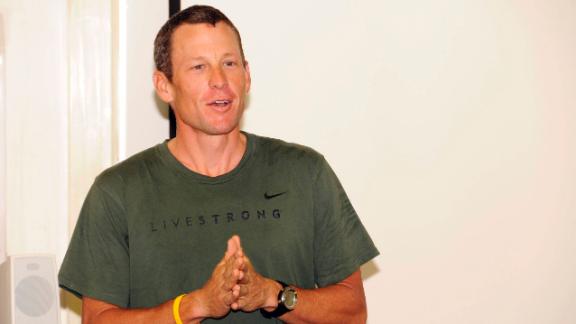Lance Armstrong Steps Down as Livestrong Chairman

Lance Armstrong has decided to step down as the Chairman of the cancer-support organization Livestrong.org.
His decision comes on the heels of a report released by the US Anti-Doping Agency (USADA) that outlines the case against Armstrong (see more below). Although Armstrong still denies doping, he decided not to continue his fight against the USADA, saying that the process is unfair and stacked against the athletes. As a result, he was stripped of his seven Tour de France wins and banned from the sport from now on.
Lance Armstrong was diagnosed with advanced testicular cancer which spread to his abdomen, lungs and brain in October of 1996, when he was only 25-years-old. At the end of his treatment, in 1997 he founded the Lance Armstrong Foundation to raise funds for cancer research.
In 2003, Livestrong.org was launched as an online resource for cancer survivors.
In a statement on the Livestrong blog, Armstrong said:
In 1996, as my cancer treatment was drawing to an end, I created a foundation to serve people affected by cancer. It has been a great privilege to help grow it from a dream into an organization that today has served 2.5 million people and helped spur a cultural shift in how the world views cancer survivors. This organization, its mission and its supporters are incredibly dear to my heart.
I have had the great honor of serving as this foundation’s chairman for the last five years and its mission and success are my top priorities. Today therefore, to spare the foundation any negative effects as a result of controversy surrounding my cycling career, I will conclude my chairmanship.
It was also announced today that Nike has ended it’s endorsement deal with Armstrong, although it will continue “to continue support of the Livestrong initiatives created to unite, inspire and empower people affected by cancer.
The Reasoned Decision of the USADA
On August 24, 2012, the United States Anti-Doping Agency (USADA) announced it had imposed a sanction of lifetime ineligibility and disqualification of competitive results achieved since August 1, 1998, on United States athlete Lance Armstrong.
Thus begins the 202 page “Reasoned Decision” by the USADA in it’s case against Lance Armstrong.
Included in the evidence in this case are the sworn statements of more than two dozen witnesses, including fifteen professional cyclists, and a dozen members of Armstrong’s cycling teams. Eleven were former teammates and one was his former masseuse.
Like Armstrong, nine of the professional cyclists were clients of Dr. Michele Ferrari with firsthand knowledge of his doping practices.
USADA credits the testimony of a number of “courageous riders” who broke the Code of Silence—the “omertà”— which enabled the organization to bring charges against Armstrong.
According to the report:
“Mr. Armstrong did not act alone. He acted with the help of a small army of enablers, including doping doctors, drug smugglers, and others within and outside the sport and on his team. However, the evidence is also clear that Armstrong had ultimate control over not only his own personal drug use, which was extensive, but also over the doping culture of his team. Final responsibility for decisions to hire and retain a director, doctors and other staff committed to running a team-wide doping program ultimately flowed to him.”
“The evidence is overwhelming that Lance Armstrong did not just use performance enhancing drugs, he supplied them to his teammates. He did not merely go alone to Dr. Michele Ferrari for doping advice, he expected that others would follow. It was not enough that his teammates give maximum effort on the bike, he also required that they adhere to the doping program outlined for them or be replaced.”
What susbstances did Armstrong use?
The agency outlined numerous instances of doping and reports that Armstrong used EPO, blood transfusions, testosterone, corticosteroids and masking agents. They also claim that he used them throughout his career.
Armstrong got his drugs through Dr. Michele Ferrari as well as others.
He used many ways to escape detection as well. For instance, at the World Championships in 1998, a UCI drug tester arrived at the bed and breakfast where Armstrong and other cyclists were staying. While the tester was setting up, a physician with the team went out to his car and smuggled in a bag of intravenous saline (salt water) under his jacket He went into Armstrong’s bedroom and gave him the infusion to lower his blood count before the tester drew his blood. Later that day, the physician recounted that they “had a good laugh about how he had been able to smuggle in saline and administer it to Lance essentially under the UCI inspector’s nose.”
What are the 6 Categories of performance-enhancing drugs?
- Lean mass enhancers- increase muscle and lean body mass. This group includes anabolic steroids, but also includes hormones, such as human growth hormone.
- Erythropoieses-stimulating agents- such as erythropoetin (EPO), which promotes red blood cell production. More red blood cells mean a greater oxygen carrying capacity which can increase endurance.
- Stimulants- such as amphetamines and caffeine, which stimulate alertness and increase aggressiveness
- Painkillers- mask pain so that athlete can compete when injured.
- Diuretics- decrease weight by increasing urine output. Used by wrestlers and jockeys who need to meet weight restrictions
- Masking drugs- usually have no performance enhancing effect on their own, but are used to mask the detection of banned substances. These drugs evolve along side drug testing techniques, changing as new testing techniques are developed. The most notable one of these drugs is epitestosterone. A common criterion for many testosterone tests is actually the ratio of testosterone to epitestosterone. If the level of epitestosterone is raised then a higher amount of testosterone will still give a normal ratio.
Does this report change your image of Lance Armstrong? Does it negate everything he has done?



























0 comments